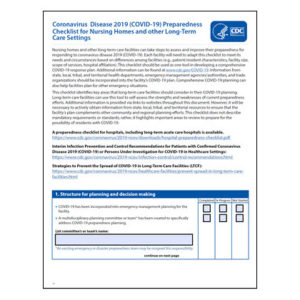10 Tips for Improved Leadership Communications
Better communication can improve your workplace culture and lead to better staff commitment and longevity.
It’s long been said that what separates us from other animals is not just our big brains and opposable thumbs, but our innate ability — and need — to communicate with other humans. Good communication is the cornerstone of every relationship and it’s absolutely critical in the senior care space, particularly among leaders and their workers.
Being a leader isn’t always easy. You have to make tough decisions, and sometimes employees don’t like the decisions you make. And the ultimate responsibility for everything that goes on in the community rests with you. But finding a way to connect with your employees, to recruit them to your side, and help support the mission of your business can help make a tough job easier.
How to do that? Jasmine Hu, Ph.D., associate professor of management and human resources at the Fisher College of Business at The Ohio State University, says finding the right motivation for employees can help reduce turnover. Pay, recognition and other external factors are nice and certainly contribute to motivation, but for lasting commitment and better outcomes, she says you also need to cultivate internal motivation and connect the work to social ideals. “Especially in the senior care industry, a lot of employees want to help people,” and cultivating those prosocial motivations in employees can help remind them why they came to this sort of work in the first place and why their daily efforts matter so much.
These social reasons are powerful motivators. “It’s a meaningful job, but not everyone notices or realizes that. It’s the leader’s responsibility to realize the difference these employees are making in the lives of others,” Hu says. When that connection between their day-to-day work and the meaning of the job is made, that can help employees overcome the tough days and feel more appreciated for what they do.
To help you improve outcomes (both for residents and employees), try these 10 tips to improve communication.
1. Connect with Employees
For you as the leader, connecting with and getting to know your employees, and sharing a bit of yourself with them, too is important. These aspects of communication can make or break any business, but especially one that deals with so much human emotion every day. You might have to share a little of yourself to make that connection. Amy Silva-Magalhaes, senior vice president of community operations for Maplewood Senior Living, a Westport, Connecticut–based senior living company with more than a dozen communities across five states, says that even when you’re guiding and coaching, you have to be part of the equation as well. “You have to offer a caring heart. You have to be deliberate and transparent and authentic in your communication. You can’t be afraid to have that courageous dialogue and really be relatable.”
2. Tailor Your Message
“The success of any leader lies in communication and how we tailor that communication style,” Silva-Magalhaes says, and this means altering how you approach different stakeholders. The way you speak with an employee or colleague is likely going to be different to how you interact with residents or their families, and that’s good. Tailoring your communication style and message allows you to show your compassion for each person’s perspective and needs, while advancing the mission of the business. “You have to be adaptive to what your audience is going through, whether it’s a senior citizen who’s recently moved in, leaving behind his home of 50 years, or it’s an associate who’s holding down three jobs and caring for that resident,” Silva-Magalhaes says.
3. Listen
Listening and coaching become the name of the game for most leaders, and in senior care facilities, listening may be your greatest tool for success. “Listen to the team and learn when to push and when not to push,” she says.
4. Stay Authentic
Though your message and how you deliver it may change from person to person, what shouldn’t change is your authenticity and your own investment in the business, the people it serves, and the individuals who help make it run. “You really have to show that you care,” Silva-Magalhaes says. “You have to practice good listing and behavioral agility. You have to be able to switch modes from listening to knowing when to give input. Knowing when to coach and when to direct and advise — that’s a skill that comes with time.”
5. Lead by Example
Leading by example is also critical, Silva-Magalhaes says, because when you’re in charge, there’s nowhere to hide. “For many leaders, especially those at the executive level, you’re constantly in the spotlight and you’re always ‘on.’ You’re the one on stage that people see — they might not see what all is happening behind the scenes, but they can see what’s happening in the spotlight, and they observe your behaviors.”
6. Set the Culture
Those behaviors and actions set the tone for everything else and create a culture in your community. If you don’t like the culture that’s developed, maybe you need to take a hard look at how you interact with staff, residents, and other stakeholders and make some difficult changes. “When it comes to emotional intelligence, you need to dig deep and reflect a bit on yourself. Ask yourself the tough questions,” Silva-Magalhaes says.
You’ll know you’re getting it right when you get the email from the adult child who was reluctant to move mom into your community that says, ‘this was the best thing we ever did.’ And you’ll know your culture is in a good place when employees you previously might have dreaded coming to work say they love their jobs.
7. Keep it Personal
At the end of the day, “what we’re doing in caring for seniors — it’s intense and every situation is unique. You need to learn to take that emotion and turn it into being relatable and listen,” Silva-Magalhaes says. “Oftentimes, people expect leaders to not show emotion, but the work we do is personal. And when you try to separate your feelings from the function, you get lost.” She also notes that with close contact, comes familiarity and even a familial feeling in some cases. “We’re living alongside the residents. When you have a resident or an adult child who’ve visited frequently over many years, they become family. They become part of our lives, and when you lose that resident or that adult child, the entire community grieves.” This is what it means to be part of a community — to share in successes and support each other in times of difficulty. It’s not a bad thing if you or staff members feel sad at the passing of a resident. In fact, it means you’re forging lasting and important relationships with others, and no doubt those relationships helped the resident feel more alive while they lived in your community because of those connections.
8. Coach with Compassion
In working directly with employees, especially in the case of an employee who needs some coaching or motivating, Silva-Magalhaes recommends working the “soft channel approach,” and building relationships over time. “Focus on the interpersonal skills when trying to build morale or maintain relationships.” One-on-one sessions with employees can help develop this and prevents critiques from becoming public floggings in front of other employees. Hu adds that one-to-one feedback sessions can build trust, and for leaders who care about performance, “it’s important to provide opportunities for meaning and improvement. That drives those social motivations,” and can make the difficult physical or emotional tasks employees are being asked to complete easier to manage.
Leaders who don’t display emotional intelligence, sensitivity, or respect for an employee’s perspective are likely to have higher turnover rates than those who listen with compassion and work with the employee to find a compromise or solution to whatever the issue might be.
9. Watch for Burnout
Silva-Magalhaes also recommends staying vigilant for signs of burnout in employees. Caregiving is emotionally and physically difficult work, and burnout is not uncommon. Keeping tabs on how your staff are coping might help you head off the problem before it becomes untenable. “Recognize when that person is burning our and maybe give them a day off,” or reach out to find out what else is going on that might be contributing to how they’re reacting. Sometimes just knowing you’re supported is enough.
10. Measure Success
How will you know if you’ve been successful as a leader? Silva-Magalhaes says it’s about a lot more than just hitting KPIs or data points. “I think the answer is pretty simple. You measure the success of an executive by the success of those around them. At the end of the day you just have to care. If you do that consistently and authentically, you’ll have a stronger business.”

Elaine K. Howley is a freelance journalist for various publications. An award-winning writer specializing in health, fitness, sports and history, her work has appeared in numerous print and online publications, including U.S. News, AARP.org, espnW, SWIMMER magazine and Atlas Obscura. She’s also a world-record holding marathon swimmer with a passion for animals and beer. Contact her via her website: elainekhowley.com.
Related Articles
Topics: Administration , Executive Leadership , Featured Articles , Leadership , Staffing











